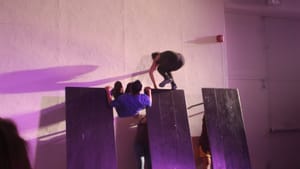Stay in the Loop
BSR publishes on a weekly schedule, with an email newsletter every Wednesday and Thursday morning. There’s no paywall, and subscribing is always free.
Empathy for émigrés and exiles
Silvana Cardell's 'Supper, People on the Move'

In the wake of the DREAM Act, calls for immigration reform, DACA (Deferred Action for Childhood Arrivals), and the Dominican Republic’s mass Haitian deportation last month, there are few artistic performances in Philadelphia as relevant or poignant as Cardell Dance Theater’s Supper, People on the Move.
Choreographed by Silvana Cardell, Supper generates undeniable empathy for immigrants, refugees, exiles, and those navigating beyond the borders of their homelands. It is not tethered to a single narrative but evokes the overall struggles inseparable from many immigrant experiences — from Cardell’s own history as an Argentine expatriate to stories told in interviews with Philadelphia-based immigrants and those Cardell met while traveling to refugee camps and the U.S.-Mexico border. The result is a work that is at once specific and universal without ever being reductive.
The audience is immediately swept into the piece, as each member must pass through an impersonal processing line to get into the show. Officials demand IDs from each audience member, creating palpable tension and confusion. Some audience members are able to pass into the performance area while others — chosen arbitrarily, it seems — are made to wait and write their names down while their IDs are further inspected. Slowly, all audience members are allowed into the foggy, backlit performance space. The officials are part of the cast, and, once out of their blue button-downs, they wear street clothes, not costumes. The audience doesn’t realize that they’re dancers — they could be any of us (by chance or by choice?), mimicking the reality of non-Americans in everyday life.
Urgency punctuated by inactivity
Set to original music by Nick Zammuto of the Books, Supper alternates urgent, fast-paced segments with gentler, almost meditative movements, suggesting the violence and urgency of immigrant life along with the waiting periods — waiting to get documents, to see a loved one, to be deported. The contrast is most apparent by the various uses of the table and supper motifs. The dancers begin at a long table set for supper, but as the performance goes on, the table is broken apart and repurposed, becoming doors for the dancers to jump through, platforms to dance upon, and barriers to climb over.
Because supper is a communal, relaxed ritual as well as the site of cultural traditions (not to mention a religious symbol), the frantic movement that comes after the initial supper conjures up the stress and exhaustion that comes with the constant change and navigation of obstacles. Beyond supper, the dancers’ activity of carrying and rearranging the tables reminds the audience of the immigrant labor on which the U.S. economy is dependent. (An additional nod to labor is a moment in which a dancer spills coffee and cleans the spill from the floor with the sweater she takes off her back.)
Fraught relationships show up in the dancers’ interactions as they fight, embrace, chase, and share weight. The group dances, which include dancers performing single-arm balances and running flips on top of the others, are extremely athletic and serve as sculptural elements throughout the piece. The dancers support one another literally and figuratively: One particularly moving moment involves a dancer sprinting horizontally along a wall, boosted by her six fellow performers. A solo of a dancer interacting with a paper document (which turns out to be a copy of Cardell’s actual visa) reminds us of how meaningful an immigrant’s relationship is to that piece of paper with its life-giving potential.
her six fellow performers. A solo of a dancer interacting with a paper document (which turns out to be a copy of Cardell’s actual visa) reminds us of how meaningful an immigrant’s relationship is to that piece of paper with its life-giving potential.
All about relationships
Even the audience members must examine their relationships to the cast and each other by the show’s conclusion, as Supper ends how it begins: with a supper and with audience participation. The audience and cast comes together to eat burritos individually wrapped and distributed — like the bundles of food provided by the women of Veracruz for those crossing the border into the United States from Central America. Conversation sparks, and what is gained through the struggle becomes clearer.
Supper, People on the Move is a thoughtful, important work for not only its serious exploration of the immigrant experience, but also as a powerful example of dance as a mode for social history and political advocacy. With effortless shifts between moods and movement styles, Supper reflects the desperation, precariousness, and turmoil of immigrant life. Supper tells the story of proximity and distance (to family, culture, country), of trying one’s hardest and losing control, of holding on and letting go.
Above right: photo by Jennifer Baker.
What, When, Where
Supper, People on the Move by Cardell Dance Theater. Silvana Cardell directed and choreographed. June 25-28, 2015, at Icebox Project Space at Crane Arts, 1400 North American St., Philadelphia. www.cranearts.com/wordpress/icebox
Sign up for our newsletter
All of the week's new articles, all in one place. Sign up for the free weekly BSR newsletters, and don't miss a conversation.